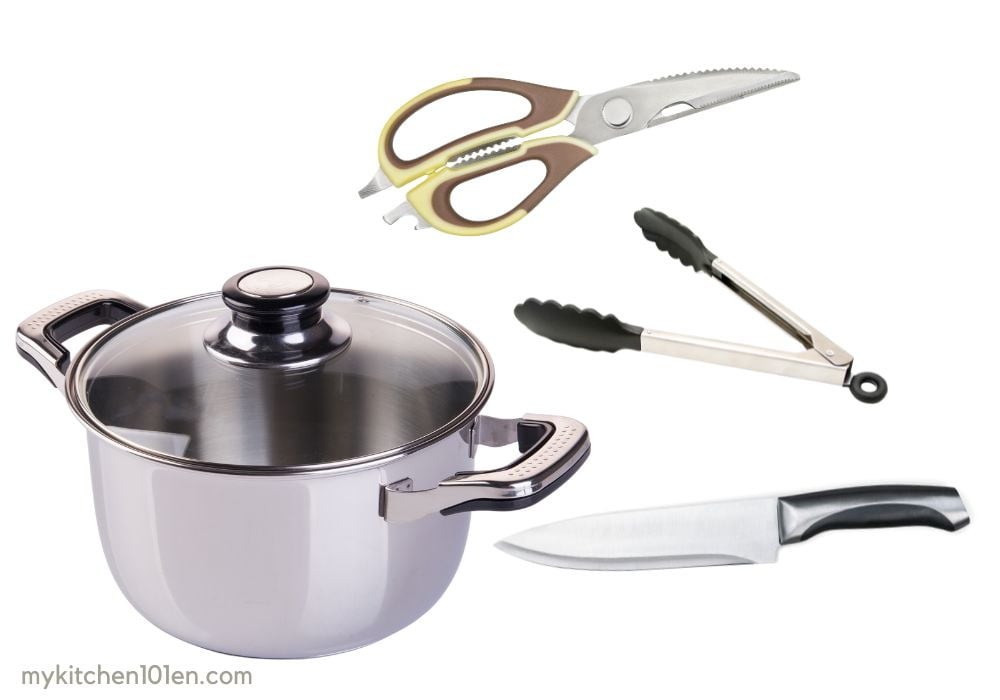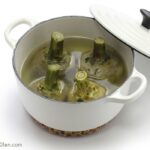Artichokes might seem a bit intimidating at first glance with their tough exterior and layered leaves. But trust me, once you get the hang of boiling them, they’re as simple to prepare as any other veggie in your kitchen.
So, if you’ve been hesitant about giving them a try, or if you’re just looking for the best way to cook them up, you’re in the right place. Let’s dive into this easy step-by-step guide on how to boil artichokes and get them plate-ready in no time!

Table of Contents
Ingredients for Boiled Artichokes
- Fresh artichokes
- Lemon (optional, to prevent discoloration)
- Salt (optional, for seasoning)
- Garlic cloves (optional, for added flavor)
Tools Needed
- A sharp knife
- A pair of kitchen scissors
- A large pot with a lid
- Tongs or a slotted spoon

How to Boil Artichokes (Video Instructions)
1 Preparing the Artichokes: Begin by trimming your artichoke. With a sharp knife in hand, cut off about the top inch of the artichoke to rid it of the spiky tips. Afterward, using kitchen scissors, snip away the pointy tips of its outer leaves. As for the stem, only leave about an inch so the artichoke can comfortably sit flat in the pot. Don’t throw the rest of the stem away; it’s as edible and tasty as the rest when cooked.

2 Cleaning artichokes is Essential: After your artichokes are prepped, it’s time to ensure they’re clean. Fill a bowl with cold water, adding a squeeze of lemon to help maintain the vibrant green color of the artichoke and prevent any browning. Gently swish the artichokes in this water, slightly separating the leaves to ensure no dirt or pests remain trapped. A thorough rinse under cold tap water afterward will do the trick.
| Tip: Use fresh artichokes that feel heavy for their size, indicating they’re full of moisture and freshness.

3 Time to Boil: For boiling, select a pot spacious enough to accommodate your artichokes and fill it with water. If you’d like to enhance the flavor, consider adding a pinch of salt, a touch of lemon, or even a few garlic cloves. Once the water reaches a rolling boil, carefully position your artichokes inside, ensuring the stem faces upward. After placing them in, reduce the flame, allowing the water to simmer, and then cover your pot.
| Tip: To ensure even cooking, choose artichokes of similar size for simultaneous boiling.

4 Boiling Duration for Artichoke: The time your artichokes need to boil will largely depend on their size. Typically, smaller ones might be ready in about 25 minutes, whereas larger artichokes could require up to 45 minutes.
| Tip: Regularly check the water level during boiling. Add more hot water to keep the artichokes submerged if necessary.

5 Checking for Doneness: Ascertaining when your artichokes are ready is fairly simple. The leaf-pull test is quite reliable: if you can effortlessly pull off one of the artichoke’s outer leaves and it feels tender at the base when bitten, it’s ready. Another method is to insert a knife into its base, which should go in smoothly without resistance when it’s done.
| Tip: Overcooking can make artichokes mushy, while undercooking leaves them tough. Regular checks after the 25-minute mark can help you gauge the right texture.

6 Drain and Serve: Once cooked to perfection, retrieve your artichokes using tongs or a slotted spoon. Invert them to drain any excess water and let them cool for a short while. Boiled artichokes can be relished both hot or cold. Enhance their taste by pairing with delectable dips like butter, aioli, or a tangy lemon vinaigrette.

Serving Suggestion for Artichokes
Boiled artichokes can be enjoyed hot or cold. They pair beautifully with various dips like melted butter, aioli, or a lemon vinaigrette. To eat, pull off the leaves one by one, dip, and scrape off the tender flesh with your teeth. Once you reach the heart (the best part!), remove the fuzzy choke with a spoon, dip, and enjoy!
The Bottom Line
Boiling artichokes is a straightforward process that, once mastered, can lead to countless delightful meals. Whether it’s a springtime treat or a cozy dinner side dish, boiled artichokes are sure to be a hit. Happy eating!

FAQs: Boiling Artichokes
Why is my boiled artichoke turning brown?
Artichokes can oxidize when cut, similar to apples. To prevent browning, immediately rub cut surfaces with lemon or immerse the trimmed artichoke in water mixed with a bit of lemon juice.
Can I eat the entire artichoke?
Not entirely. The outer leaves, stem, and heart are edible, but the innermost leaves and the fuzzy part, known as the “choke”, are inedible and should be discarded.
How long can I store boiled artichokes?
Once boiled, artichokes can be refrigerated in an airtight container for up to 3-4 days. Make sure they’re cooled completely before storing.
Can I boil artichokes ahead of time and reheat them later?
Yes, boiled artichokes can be reheated. To do so, steam them for a few minutes or microwave covered with a damp paper towel until heated through.
How can I tell if an artichoke is fresh when purchasing?
A fresh artichoke feels heavy for its size and has tightly closed, green leaves. If the leaves are split, dried out, or turning brown, it’s likely past its prime.
What are the health benefits of artichokes?
Artichokes are a rich source of fiber, vitamins C and K, folate, and minerals like magnesium and potassium. They also contain antioxidants and can support liver health.
I don’t have a lemon. What else can I use to prevent browning?
While lemon is the most common, you can also use white vinegar or vitamin C (ascorbic acid) tablets dissolved in water as alternatives to prevent oxidation.
How do I serve artichokes as part of a main dish?
Boiled artichokes can be halved or quartered and then grilled, added to salads, or used as a topping for pizzas and flatbreads. They also make a great accompaniment to meat or fish dishes.
Are there any other methods to cook artichokes besides boiling?
Absolutely! Artichokes can be grilled, steamed, roasted, or even made into a delicious creamy soup. The method you choose often depends on the specific dish and your personal preference.
How do I prevent my fingers from getting stained while handling artichokes?
Handling artichokes, especially older ones, can sometimes lead to slightly stained fingers due to their natural juices. Wearing kitchen gloves while preparing them can prevent this.
How to Boil Artichokes

Let’s dive into this easy step-by-step guide on how to boil artichokes and get them plate-ready in no time!
- sharp knife
- kitchen scissors
- large pot with a lid
- Tongs or a slotted spoon
- Fresh artichokes
- Lemon (optional, to prevent discoloration)
- Salt (optional, for seasoning)
- Garlic cloves (optional, for added flavor)
Boiled artichokes can be enjoyed hot or cold. They pair beautifully with various dips like melted butter, aioli, or a lemon vinaigrette.










